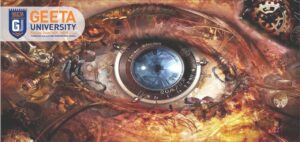Unveiling Mysteries with Lip Prints: Exploring Forensic Cheiloscopy
UncategorizedIntroducation
- May 5, 2024
- Geeta University

Forensic cheiloscopy, also known as lip print analysis, is a specialized field within forensic science that focuses on identifying individuals based on the unique patterns and characteristics of their lip prints. Just like fingerprints, lip prints are formed by ridges and furrows, making them distinctive to each person. Here’s a deep dive into this intriguing forensic technique:
The term “father of lip prints” is often attributed to Dr. S. S. Tsuchihashi, a Japanese forensic scientist who made significant contributions to the study of lip prints, also known as cheiloscopy. Dr.Tsuchihashi’s research in the mid-20th century helped establish lip print analysis as a legitimate forensic science technique.
In the 1970s, Dr.Tsuchihashi developed a classification system for lip prints based on the arrangement of grooves and furrows on the lips. His classification system categorized lip prints into various types, similar to fingerprint classification systems, and provided a standardized framework for analyzing and comparing lip prints.
Dr.Tsuchihashi’s work laid the foundation for subsequent research in the field of cheiloscopy and helped raise awareness of the potential applications of lip prints in forensic investigations. While he is often credited as the “father of lip prints,” it’s important to acknowledge the contributions of other researchers and scientists who have furthered our understanding of this unique forensic technique.

Admission Open 2024-2025
For Your bright Future
Understanding Lip Prints:
Lip prints are the patterns formed by the ridges and furrows on the vermilion border (the edge) of the lips. These patterns can be categorized into different types, such as grooves, furrows, and dots, and they are influenced by factors like genetics and lip morphology. Lip prints can be visible (formed by substances like lipstick or blood) or latent (invisible to the naked eye and requiring enhancement techniques for visualization).
History of Cheiloscopy:
The history of cheiloscopy, the study of lip prints for forensic identification, traces back to the late 19th century with the pioneering work of French anthropologist Edmond Locard. However, it wasn’t until the 20th century that cheiloscopy began to gain recognition as a legitimate forensic science technique.
Edmond Locard, known as the “Sherlock Holmes of France,” was one of the earliest researchers to recognize the potential of lip prints for identification purposes. In 1932, he published a paper titled “L’EnqueteCriminelle et les MethodesScientifiques” (Criminal Investigation and Scientific Methods), in which he discussed the significance of lip prints as unique identifiers. Locard proposed that lip prints, like fingerprints, could be used to identify individuals and aid in criminal investigations.
Following Locard’s initial observations, interest in cheiloscopy grew among forensic scientists and researchers worldwide. Throughout the 20th century, numerous studies were conducted to explore the patterns and characteristics of lip prints and their potential applications in forensic science.
One significant milestone in the history of cheiloscopy was the establishment of standardized classification systems for lip prints. In the 1970s, Japanese researcher Yoshino introduced a classification system based on the arrangement of grooves and furrows in lip prints, laying the foundation for subsequent research in the field.
In the decades that followed, cheiloscopy gained traction as a valuable tool in criminal investigations. Forensic experts began to develop methods for analyzing lip prints, including visual inspection, photography, and digital imaging techniques. These advancements helped enhance the visibility of latent lip prints and improve the accuracy of comparisons between prints found at crime scenes and those of suspects or victims.
Today, cheiloscopy continues to evolve as a specialized branch of forensic science. Ongoing research efforts focus on refining analysis techniques, standardizing classification systems, and expanding databases of lip prints for reference. Interdisciplinary collaborations with fields like dermatoglyphics and genetics hold promise for further advancing the capabilities of cheiloscopy in the identification of individuals and the resolution of criminal cases.
Overall, the history of cheiloscopy reflects the journey of a once-nascent forensic technique to a recognized and valuable tool in the arsenal of forensic investigators, contributing to the pursuit of justice and the resolution of mysteries worldwide.
Methods of Lip Print Analysis:
Forensic experts employ various methods to analyze lip prints, including visual inspection, photography, and digital imaging. Advanced techniques like digital enhancement and computer-based analysis software are also utilized to enhance the visibility of latent lip prints and compare patterns with existing databases.
Applications in Forensic Investigations:
Lip print analysis has been used in a wide range of criminal cases, including homicides, sexual assaults, and unidentified remains. By comparing lip print patterns found at crime scenes with those of suspects or victims, forensic investigators can establish links and aid in the identification process. Lip prints have even been used to identify individuals from partial remains or when other forms of identification are unavailable.
Challenges and Limitations:
Despite its potential, cheiloscopy has its limitations. The visibility of lip prints can be affected by factors like environmental conditions and the quality of the surface they are deposited on. Additionally, the lack of standardized classification systems and databases for lip prints can hinder comparisons and analysis. Furthermore, the reliability of lip print analysis can be influenced by subjective interpretation, highlighting the need for rigorous training and expertise in this field.
Ethical Considerations:
As with any forensic technique, ethical considerations are paramount in the application of cheiloscopy. Issues such as consent, privacy, and potential biases must be carefully addressed to ensure the fair and responsible use of lip print analysis in criminal investigations.
Future Directions:
Despite its challenges, cheiloscopy continues to evolve as a valuable tool in forensic science. Ongoing research efforts aim to improve the accuracy and reliability of lip print analysis through advancements in technology, standardization of methodologies, and expansion of databases. Additionally, interdisciplinary collaborations with fields like dermatoglyphics (the study of fingerprints) and genetics hold promise for further enhancing the capabilities of cheiloscopy.
The analysis of lip prints, also known as cheiloscopy, involves several methods aimed at identifying individuals based on the unique patterns and characteristics of their lip prints. These methods vary in complexity and may include visual inspection, photography, digital imaging, and computer-based analysis. Here’s an overview of the main methods used in lip print analysis:
Visual Inspection:
Visual inspection is the most basic method of lip print analysis. Forensic experts examine lip prints under appropriate lighting conditions and with the naked eye to identify patterns and characteristics such as grooves, furrows, and dots. This method is often used initially to assess the quality and visibility of lip prints before applying more advanced techniques.
Photography:
Photography is a common method used to document lip prints for further analysis. High-resolution cameras are used to capture clear images of lip prints, which can then be examined and compared by forensic experts. Photography allows for detailed documentation of lip print patterns and facilitates comparisons between prints found at crime scenes and those of suspects or victims.
Digital Imaging:
Digital imaging techniques involve the use of specialized equipment, such as scanners or digital cameras, to capture and digitize lip prints. Digital images of lip prints can be enhanced and manipulated using software tools to improve visibility and highlight specific features. Digital imaging offers greater flexibility and precision compared to traditional photography and allows for more detailed analysis of lip print patterns.
Computer-Based Analysis:
Computer-based analysis involves the use of software algorithms to analyze and compare lip print patterns. These algorithms can automatically identify and extract features from digital images of lip prints, such as ridge contours and intersections. Computer-based analysis streamlines the process of comparing lip prints and can help identify potential matches more efficiently. However, human expertise is still required to interpret the results and make final determinations.
Chemical Enhancement:
In cases where lip prints are latent or faint, chemical enhancement techniques may be employed to improve visibility. Chemical reagents, such as ninhydrin or iodine fuming, can be applied to surfaces to develop latent lip prints. These reagents react with lipids and other components of lip prints, causing them to become visible. Chemical enhancement techniques can significantly enhance the quality of latent lip prints and make them suitable for further analysis.
Fluorescent Techniques:
Fluorescent techniques involve the use of fluorescent dyes or powders to enhance the visibility of lip prints under specific wavelengths of light. Fluorescent materials applied to lip prints emit light at different wavelengths, making them stand out against the background and facilitating visualization and documentation. Fluorescent techniques can be particularly useful for detecting and analyzing latent lip prints on difficult surfaces.
Each of these methods has its advantages and limitations, and forensic experts may employ a combination of techniques depending on the specific circumstances of a case. Ultimately, the goal of lip print analysis is to accurately identify individuals and provide valuable evidence for criminal investigations.
Challenges and Limitations
While lip print analysis, or cheiloscopy, holds promise as a forensic tool, it also comes with several challenges and limitations that must be considered:
Visibility and Quality of Lip Prints:
One of the primary challenges in lip print analysis is the variability in the visibility and quality of lip prints. Factors such as the type of surface, the presence of contaminants, and environmental conditions can affect the clarity and integrity of lip prints. In some cases, lip prints may be faint or incomplete, making them difficult to analyze and compare.
Subjectivity in Interpretation:
Lip print analysis often involves subjective interpretation by forensic experts. While there are classification systems and guidelines for identifying and categorizing lip print patterns, there can be variability in how different analysts interpret and classify prints. This subjectivity can introduce a degree of uncertainty into the analysis process and may affect the reliability of results.
Lack of Standardization:
Another challenge in lip print analysis is the lack of standardized methodologies and classification systems. While efforts have been made to develop classification systems for lip prints, there is still no universally accepted standard. The absence of standardization can hinder consistency and comparability between analyses conducted by different forensic experts or laboratories.
Limited Databases:
The effectiveness of lip print analysis relies on the availability of reference databases containing known lip print patterns for comparison. However, such databases are often limited in size and scope, particularly compared to fingerprint databases. The lack of comprehensive databases can make it challenging to identify individuals based on lip prints alone, especially in cases where there are no suspects or known individuals to compare against.
Environmental Factors:
Lip prints deposited at crime scenes may be subject to degradation over time due to environmental factors such as sunlight, moisture, or contamination. These environmental factors can alter the appearance of lip prints and affect their viability for analysis. Additionally, lip prints may be inadvertently altered or destroyed during the collection and preservation process, further complicating analysis.
Ethical Considerations:
The use of lip print analysis in forensic investigations raises ethical considerations related to privacy, consent, and potential biases. Collecting lip prints from individuals without their consent, or using lip prints as the sole basis for identification without corroborating evidence, may raise concerns about individual rights and due process.
Legal Acceptance:
While lip print analysis has been used in criminal investigations, its legal acceptance varies depending on jurisdiction and case law. Some courts may view lip print analysis as less reliable or scientifically established compared to other forensic techniques such as fingerprint or DNA analysis. Admissibility challenges may arise in court proceedings, requiring forensic experts to demonstrate the validity and reliability of lip print analysis.
In conclusion, while lip print analysis, or cheiloscopy, offers significant potential as a forensic tool for identifying individuals and aiding in criminal investigations, it also comes with several challenges and limitations. The visibility and quality of lip prints can vary, making analysis and comparison difficult. Subjectivity in interpretation, the lack of standardization, and limited databases further complicate the reliability and consistency of lip print analysis.
Environmental factors, ethical considerations, and legal acceptance also pose challenges to the widespread use of lip print analysis in forensic investigations. However, despite these challenges, lip print analysis remains a valuable technique that can provide valuable evidence in certain cases.
Moving forward, addressing these challenges will require ongoing research, standardization efforts, and advancements in technology. Improving the visibility and quality of lip prints, developing standardized methodologies and classification systems, expanding reference databases, and addressing ethical and legal considerations are all essential steps in enhancing the reliability and effectiveness of lip print analysis.
Ultimately, while lip print analysis may not be suitable for every case and must be used in conjunction with other forensic techniques, it has the potential to contribute valuable evidence to criminal investigations and help in the pursuit of justice. With continued refinement and development, lip print analysis can continue to evolve as a valuable tool in the forensic scientist’s toolkit, aiding in the identification of individuals and the resolution of mysteries for years to come.

Mr. Ankit Kumar
Assistant Professor, Forensic Science
Geeta University
Tags
Related Posts

Why career guidance is important after 10th and 12th class – Geeta University
More than 95% students pass their class 10th and 12th Board examination, but how many of them make an effective choice post the completion of their respective educational milestones. It is rather significant to be mindful of the choices you

Best Courses After 12th Commerce, Future, Scope and Career Prospects – Geeta University
If you do Mathematics as an additional subject in classes 11 and 12, you are eligible for many courses as a second-degree qualified student. All of these subjects validate the need for Mathematics as a subject. In this competitive world,

Diploma Courses in Engineering After Class 10th – Geeta University
Do you enjoy creating, designing, constructing, and maintaining tools and machines? If so, engineering is the ideal career for you. For those who desire to pursue technical education while also beginning their careers early, a diploma in engineering is a
